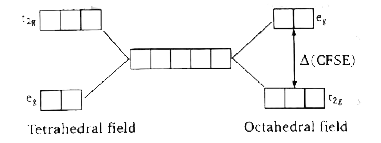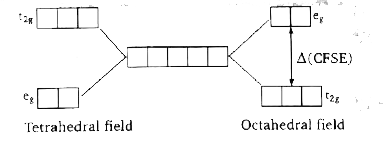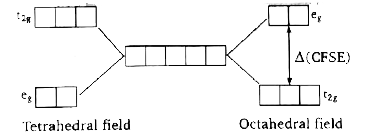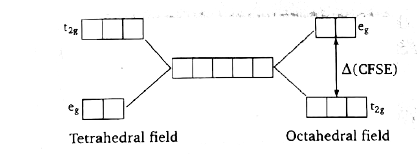LEVEL 3 (PASSAGE TYPE) from VK JAISWAL CHEMISTRY (HINGLISH) CO-ORDINATION COMPOUNDS for Class 12
| Class 12 | CHEMISTRY |
| Chapter | CO-ORDINATION COMPOUNDS |
| VK JAISWAL CHEMISTRY (HINGLISH) | LEVEL 3 (PASSAGE TYPE) |
| Medium | English |
| Academic Year | 2023-2024 |
Question 1
Magnetic moment, ionic conductance and colligative properties are useful in deciding structure/constitution of a given unknown complex compound.
Q. if molar conductivity of complex is almost equal to that of NaCl and it does not exhibits stereioisomerism then the complex will be:View SolutionQuestion 2
Magnetic moment, ionic conductance and colligative properties are useful in deciding structure/constitution of a given unknown complex compound.
Q. A metal M having elecftronic configuration (n−1)d8ns2 forms complexes with co-ordination No.=4 and 6, if it forms diamagnetic complexes then permissible oxidation states of metal cation and geometry is:View SolutionQuestion 8
The magnetic property, dipole moment, plane of symmetry, colour and absorption band cann be helpful in structure elucidation of complex compounds:
Q. Compound 'x' has molecular formula CrCl2Br⋅6H2O can show type of isomerism.
(i) hydrate isomerism
(ii) ionization isomerism
(iii) geometrical isomerism
(iv) optical isomerismView SolutionQuestion 9
The magnetic property, dipole moment, plane of symmetry, colour and absorption band cann be helpful in structure elucidation of complex compounds:
Q. Complex compound() having even number of space (stereo) isomers is/are: (Where AA-symmetrical bidentate ligand ad a,b,c,d,e-monodentate ligands)View SolutionQuestion 10
Ligands are broadly classified into two classes classical and non-classical ligands, depending on their donor annd acceptor ability. Classical ligands form classical complexes while non-classical ligands form non-classical complex. Bonding mechanism in non-classical is called synergic bonding.
Q. Synergic bonding is absent in:View SolutionQuestion 11
Ligands are broadly classified into two classes classical and non-classical ligands, depending on their donor annd acceptor ability. Classical ligands form classical complexes while non-classical ligands form non-classical complex. Bonding mechanism in non-classical is called synergic bonding.
Q. Which is not π-acceptor ligand?View SolutionQuestion 12
Ligands are broadly classified into two classes classical and non-classical ligands, depending on their donor annd acceptor ability. Classical ligands form classical complexes while non-classical ligands form non-classical complex. Bonding mechanism in non-classical is called synergic bonding.
Q. In compound [M(CO)n]x, the correct match for highest 'M-C' bond length for given M, n and z respectively:View SolutionQuestion 16
Crystal field theory provides correct electronic distribution of central metal under surrounding ligannd field, hence it clearly explains magnetic moment, colour of a complex.
Q. In which of the following complex transition of electron occurs from one shell to other shell of central metal. View SolutionQuestion 18
Two important physical evidence support the synergic bonding in non-classical complexes-bond lengths and vibrational spectra. Vibrational spectra is based on the fact that the compression and extension of a bond may be analogous to the behaviour of spring and obeys Hooke's law.
−v=12πc√Kμcm−1 Where, K=force constant of the bond which is directly proportional to bond strngth
μ=reduced mass of ligand
−v=stretching frequency of the CO bond
C=velocity of light
In which of the following complex, stretching frquency for C-O bond is least as well as bond energy of M-C bond is highest ?View SolutionQuestion 19
Two important physical evidences supporting the synergic bonding in non-classical complexes are bond lengths and vibrational spectra. Vibrational spectra is based on the fact that the compression and extension of a bond may be analogous to the behaviour of a spring and obeys Hook's law.
¯v=12πc√kμcm−1
where, k=force force constant of the bond which is directly proportional to bonnd strength of CO μ=reduced mass of ligand
¯v=stretching frequency of the CO bond
c=velocity of light
Q. In Mn2(CO)10 carbonyl complex, the d-orbital of Mn-atom which can not be involved in synergic bonding betwee Mn and CO ligands:View SolutionQuestion 20
Two important physical evidences supporting the synergic bonding in non-classical complexes are bond lengths and vibrational spectra. Vibrational spectra is based on the fact that the compression and extension of a bond may be analogous to the behaviour of a spring and obeys Hook's law.
¯v=12πc√kμcm−1
where, k=force force constant of the bond which is directly proportional to bonnd strength of CO μ=reduced mass of ligand
¯v=stretching frequency of the CO bond
c=velocity of light
Q. In which of the following ligand, σ-bond order does not change during synergic bonding in their respective complexes:View SolutionQuestion 21
Complex compounds that have the same molecular formula but have different structural/space arrangements of ligands around central metal atom/ion are called isomers, these are of two types namely structural and stereoisomers.
Q. Which of the following is different among structural isomers?View SolutionQuestion 22
Complex compounds that have the same molecular formula but have different structural/space arrangements of ligands around central metal atom/ion are called isomers, these are of two types namely structural and stereoisomers.
Q. Type of isomerism exhibited by [CrCl2(NO)2)2(NH3)2]− complex ion are:View SolutionQuestion 24
A complex compound of chromium chromium contains five NH3 molecules, one nitro group and two chloride ions for one Cr3+ cation. One molecule of this compound produces three ions in aq. Solution, on reacting with excess of AgNO3 solution, two moles of AgCl get precipitated ltBrgt Q. The formula of the complex compound is:View SolutionQuestion 25
A complex compound of chromium chromium contains five NH3 molecules, one nitro group and two chloride ions for one Cr3+ cation. One molecule of this compound produces three ions in aq. Solution, on reacting with excess of AgNO3 solution, two moles of AgCl get precipitated ltBrgt Q. The types of isomerism shown by the complex compound is:View SolutionQuestion 26
A complex compound of chromium chromium contains five NH3 molecules, one nitro group and two chloride ions for one Cr3+ cation. One molecule of this compound produces three ions in aq. Solution, on reacting with excess of AgNO3 solution, two moles of AgCl get precipitated ltBrgt Q. Magnetic moment off complex compound is:View SolutionQuestion 27
According to C.F.T, attraction between the central metal ion and ligands in a complex is purely electrostatic. The transition metal which forms the central atom cation in the complex is regarded as a positive ion. It is surrounded by negative ligands or neutral molecules which have a lone apir of electrons, if the ligand is a neutral molecule such as NH3, the negative and of the dipole in the molecule is directed towards the metal cation. the electrons on the central metal ion are under repulsive forces from those on the ligands. thus the electrons occupy the d-orbitals remain away from the direction of approach ligands. ltBrgt Q. Correct relationship between pairing energy (P) and C.F.S.E. (Δo) inView SolutionQuestion 28
According to C.F.T, attraction between the central metal ion and ligands in a complex is purely electrostatic. The transition metal which forms the central atom cation in the complex is regarded as a positive ion. It is surrounded by negative ligands or neutral molecules which have a lone apir of electrons, if the ligand is a neutral molecule such as NH3, the negative and of the dipole in the molecule is directed towards the metal cation. the electrons on the central metal ion are under repulsive forces from those on the ligands. thus the electrons occupy the d-orbitals remain away from the direction of approach ligands. ltBrgt Q. The crystal field-spliting order for Cr3+ cation is octahedral field for ligands CH3COO−,NH3,H2O,CN− is:View SolutionQuestion 29
According to C.F.T, attraction between the central metal ion and ligands in a complex is purely electrostatic. The transition metal which forms the central atom cation in the complex is regarded as a positive ion. It is surrounded by negative ligands or neutral molecules which have a lone apir of electrons, if the ligand is a neutral molecule such as NH3, the negative and of the dipole in the molecule is directed towards the metal cation. the electrons on the central metal ion are under repulsive forces from those on the ligands. thus the electrons occupy the d-orbitals remain away from the direction of approach ligands. ltBrgt Q. The value of 'x' in the complex Hx[Co(CO)4] (on the basis of EAN rule), and geometry arround Co ion respectively is:View SolutionQuestion 30
An isomer of the complex Co(en)2(H2O)ICl2, on reaction with concentrated H2SO4, it suffers loss in weight and on reaction with AgNO3 solution gives a yellow precipitated which is isoluble in NH3 solution.
Q. If all the ligandsin the co-ordination sphere of the above complex are replaced by CN− ion, then the magnetic moment of the complex ion will be:View SolutionQuestion 31
An isomer of the complex Co(en)2(H2O)ICl2, on reaction with concentrated H2SO4, it suffers loss in weight and on reaction with AgNO3 solution gives a yellow precipitated which is isoluble in NH3 solution.
Q. If one mole of original is treated with excess Pb(NO3)2 solution, then the number of moles of white precipitate formed will beView SolutionQuestion 32
An isomer of the complex Co(en)2(H2O)ICl2, on reaction with concentrated H2SO4, it suffers loss in weight and on reaction with AgNO3 solution gives a yellow precipitated which is isoluble in NH3 solution.
Q. Total number of space isomers of the formula of the above complex is:View SolutionQuestion 33
In complexes off wea field ligands, Δo<P (pairing energy), the energy difference between t2gandeg sets is relatively less. Under the unfluence of strong field ligands, ΔO>p (Pairing energy), the energy difference between t2gandeg sets is relatively high.
Q. Which of the following is correct statement?View SolutionQuestion 34
In complexes off wea field ligands, Δo<P (pairing energy), the energy difference between t2gandeg sets is relatively less. Under the unfluence of strong field ligands, ΔO>p (Pairing energy), the energy difference between t2gandeg sets is relatively high.
Q. Select the correct increasing order of 10 Dq. value of chromium complexes:
(1) [Cr(en)3]3+
(2) [Cr(ox)3]3− ltBrgt (3) [CrF6]3−
(4) [Cr(H2O)6]3+View SolutionQuestion 35
In complexes off wea field ligands, Δo<P (pairing energy), the energy difference between t2gandeg sets is relatively less. Under the unfluence of strong field ligands, ΔO>p (Pairing energy), the energy difference between t2gandeg sets is relatively high.
Q. Select the correct statement regarding [Cr(en)2Cl2]+and[Co(C2O4)2(NH3)2]− complex ions:View SolutionQuestion 36
Complex compounds are molecular compounds which retain their identities even when dissolved in water. They do not give all the simple ions in solution but instead furnish complex ions. The complex compounds are often called coordination compounds because certain groups called ligands are attached to the central metal ion by coordinate or dative bonds. coordination compounds exhibit isomerism, both structural and stereoisomerism. the structure, magnetic property, colour and electrical properties of complexes are explained by various theories:
Q. Arrange the following compounds in order of their molar conductance:
(i) K[Co(NO2)4(NH3)2]
(ii) [Cr(ONO)3(NH3)2]
(iii) [Cr(NO2)(NH3)5]3[Co(NO2)6]2
(iv) Mg[Cr(NO2)5(NH3)]View SolutionQuestion 37
Complex compounds are molecular compounds which retain their identities even when dissolved in water. They do not give all the simple ions in solution but instead furnish complex ions. The complex compounds are often called coordination compounds because certain groups called ligands are attached to the central metal ion by coordinate or dative bonds. coordination compounds exhibit isomerism, both structural and stereoisomerism. the structure, magnetic property, colour and electrical properties of complexes are explained by various theories:
Q. The oxidation number, coordination number and magnetic moment in the following complex is:
[Cr(C2O4)2(NH3)−2]View SolutionQuestion 38
Complex compounds are molecular compounds which retain their identities even when dissolved in water. They do not give all the simple ions in solution but instead furnish complex ions. The complex compounds are often called coordination compounds because certain groups called ligands are attached to the central metal ion by coordinate or dative bonds. coordination compounds exhibit isomerism, both structural and stereoisomerism. the structure, magnetic property, colour and electrical properties of complexes are explained by various theories:
Q. In which of the following pairs, both the complexes have the same geometry?View SolutionQuestion 41
On the basic of stability of complex ion in the solution, complexes may be of two types, perfect and imperfect complexes. The stability depends upon the extent of dissociation which in turn depends upon charge on central metal atom, basic nature of ligand, chelation, and nature of metal ion and ligand according to HSAB principle.
Qgt Which one of the following does not follow EAN rule?View SolutionQuestion 42
On the basic of stability of complex ion in the solution, complexes may be of two types, perfect and imperfect complexes. The stability depends upon the extent of dissociation which in turn depends upon charge on central metal atom, basic nature of ligand, chelation, and nature of metal ion and ligand according to HSAB principle.
Q Which complex is most stable?View SolutionQuestion 43
When degenerate d-orbitals of an isolated atom/ion come under influence of magnetic field of ligands, the degeneray is lost. The two set t2g(dxy,dyz,dxz)andeg(dx2−dx2−y2 are either stabilized or destabilized depending upon the nature of magnetic field. it can be expressed diagrammatically as:

Value of CFSE depends upon nature of ligand and a spectrochemical series has been made experimentally, for tetrahedral complexes, Δ is about 4/9 times to Δ0 (CFSE for octahedral complex). this energy lies in visible region and i.e., why electronic transition are responsible for colour. such transition are not possible with d0andd10 configuration.
Q. Cr3+ form four complexes with four different ligands which are [Cr(Cl)6]3−,[Cr(H2O)6]3+,
[Cr(NH3)6]3+and[Cr(CN)6]3−, the order of CFSE (Δ0) in these complexes in the order:View SolutionQuestion 44
When degenerate d-orbitals of an isolated atom/ion come under influence of magnetic field of ligands, the degeneray is lost. The two set t2g(dxy,dyz,dxz)andeg(dx2−dx2−y2 are either stabilized or destabilized depending upon the nature of magnetic field. it can be expressed diagrammatically as:

Value of CFSE depends upon nature of ligand and a spectrochemical series has been made experimentally, for tetrahedral complexes, Δ is about 4/9 times to Δ0 (CFSE for octahedral complex). this energy lies in visible region and i.e., why electronic transition are responsible for colour. such transition are not possible with d0andd10 configuration.
Q. The d-orbitals, which are stabillized in an octahedral magnetic field, are:View SolutionQuestion 45
When degenerate d-orbitals of an isolated atom/ion come under influence of magnetic field of ligands, the degeneray is lost. The two set t2g(dxy,dyz,dxz)andeg(dx2−dx2−y2 are either stabilized or destabilized depending upon the nature of magnetic field. it can be expressed diagrammatically as:

Value of CFSE depends upon nature of ligand and a spectrochemical series has been made experimentally, for tetrahedral complexes, Δ is about 4/9 times to Δ0 (CFSE for octahedral complex). this energy lies in visible region and i.e., why electronic transition are responsible for colour. such transition are not possible with d0andd10 configuration.
Q. For an octahedral complex, which of the followin d-electron configuration will give maximum CFSE? View SolutionQuestion 46
When degenerate d-orbitals of an isolated atom/ion come under influence of magnetic field of ligands, the degeneray is lost. The two set t2g(dxy,dyz,dxz)andeg(dx2−dx2−y2 are either stabilized or destabilized depending upon the nature of magnetic field. it can be expressed diagrammatically as:

Value of CFSE depends upon nature of ligand and a spectrochemical series has been made experimentally, for tetrahedral complexes, Δ is about 4/9 times to Δ0 (CFSE for octahedral complex). this energy lies in visible region and i.e., why electronic transition are responsible for colour. such transition are not possible with d0andd10 configuration.
Q. Ti3+(aq). is purple while Ti4+(aq). is colourless because:View SolutionQuestion 47
When degenerate d-orbitals of an isolated atom/ion come under influence of magnetic field of ligands, the degeneray is lost. The two set t2g(dxy,dyz,dxz)andeg(dx2−dx2−y2 are either stabilized or destabilized depending upon the nature of magnetic field. it can be expressed diagrammatically as:

Value of CFSE depends upon nature of ligand and a spectrochemical series has been made experimentally, for tetrahedral complexes, Δ is about 4/9 times to Δ0 (CFSE for octahedral complex). this energy lies in visible region and i.e., why electronic transition are responsible for colour. such transition are not possible with d0andd10 configuration.
Q. Which of the following is correct arrangement of ligand in terms of the Dq values of their complexes with any particularr 'hard' metal ion:View SolutionQuestion 48
When degenerate d-orbitals of an isolated atom/ion come under influence of magnetic field of ligands, the degeneray is lost. The two set t2g(dxy,dyz,dxz)andeg(dx2−dx2−y2 are either stabilized or destabilized depending upon the nature of magnetic field. it can be expressed diagrammatically as:

Value of CFSE depends upon nature of ligand and a spectrochemical series has been made experimentally, for tetrahedral complexes, Δ is about 4/9 times to Δ0 (CFSE for octahedral complex). this energy lies in visible region and i.e., why electronic transition are responsible for colour. such transition are not possible with d0andd10 configuration.
Q. The extent of crystal field splitting in octahedral complexes of the given metal with particular weak field ligand are:View Solution

